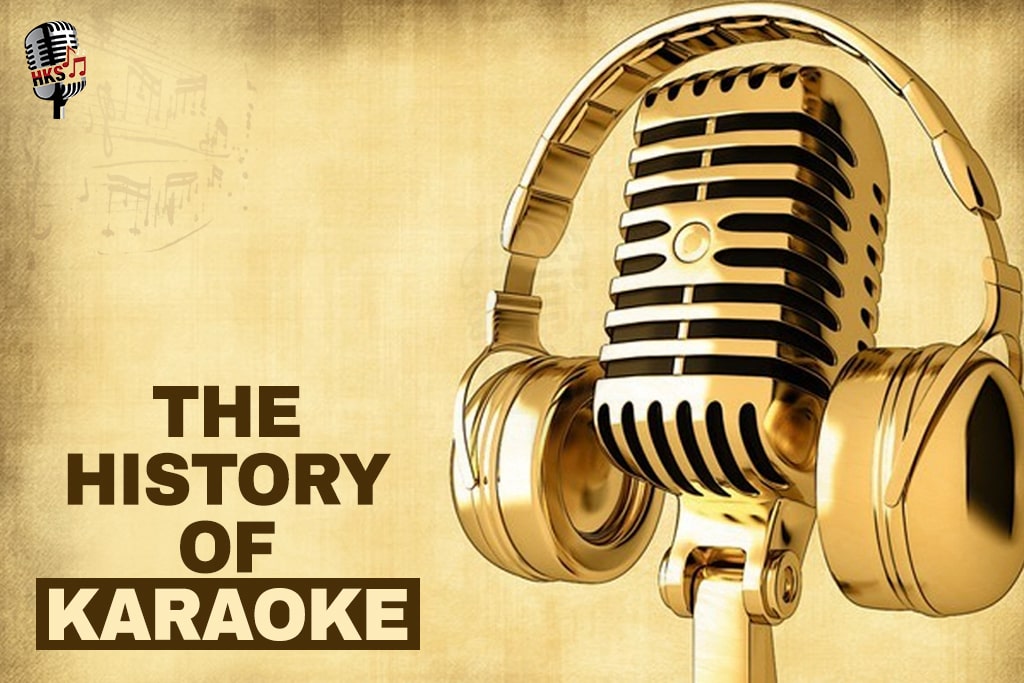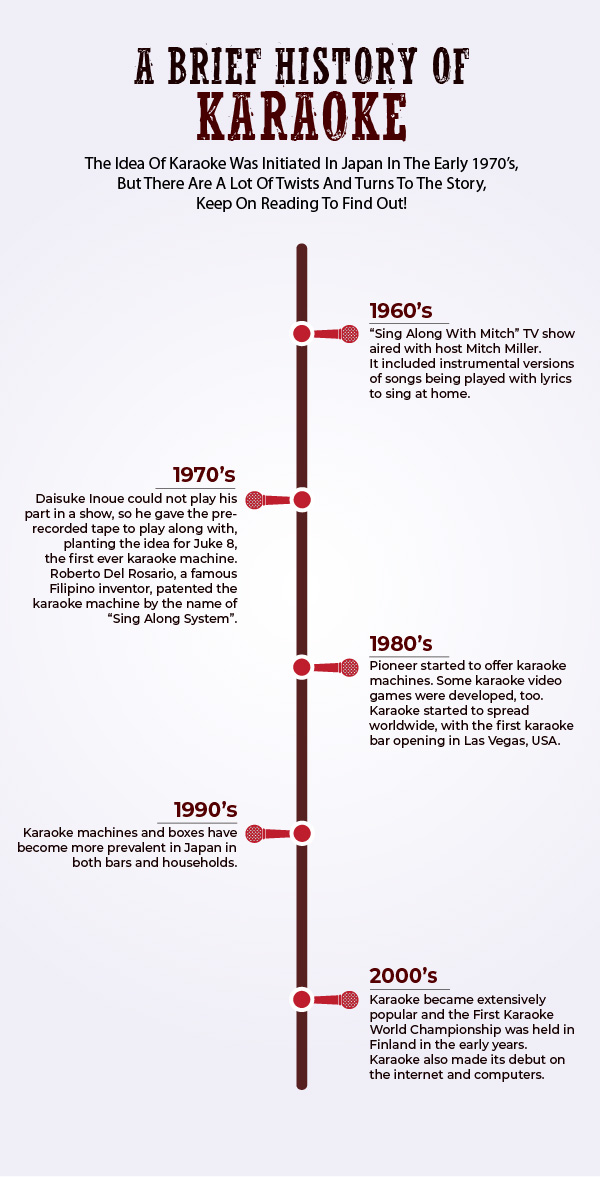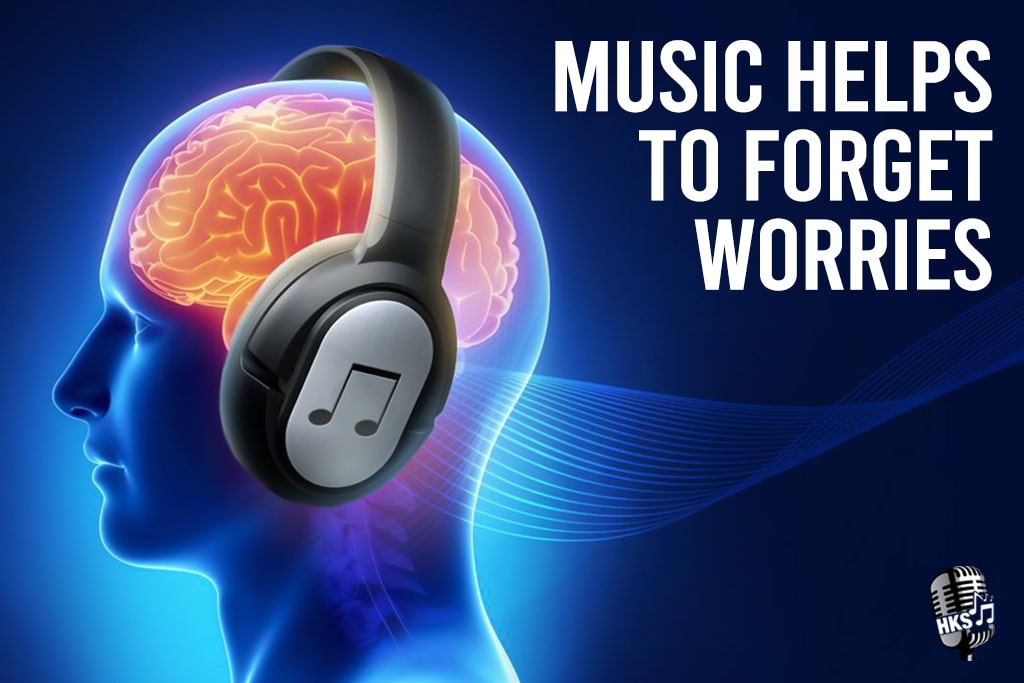Black Friday Store Wide Sale | 35% Off | USE COUPON CODE - BLACKFRIDAY35

Singing is the workout for our throat, and it directly affects our voice. The more you sing, the more you practice, the better you get at it. And the best part is that we enjoy singing, with or without music. Some of us play instruments to accompany our singing, like the guitar or the piano. Having an instrument playing along while you sing is essential; it helps you to remain in pitch, and you can clearly understand if you make a mistake because it just sounds "not right".
But at times, we can get too tired to play our instrument, or we just don't have enough time to tune into the guitar or figure out the chords to the song; these are the moments when we take out our phone and switch to karaoke tracks to practice.
Karaoke is a Japanese word derived from Kara, meaning empty, and okesutora, which means orchestra. So, karaoke literally translates to 'empty orchestra'. Karaoke's generally are sung into microphones with lyrics being displayed and highlighted on a screen, which can also be done on a smartphone, thanks to technology.
The karaoke as we see and hear today has not always been the same. It has undergone major changes, from being huge machines set up in karaoke bars to being stored in our phones to jam at karaoke parties with family, it has been quite a journey. Like any other innovation, it was first thought that karaoke would always be something that would not be used very frequently, seeing the size of the karaoke machines and the cost of Karaoke Songs. But how did it all happen? Let's glance at the history of karaoke.

- The invention of The Karaoke and the First-Ever Karaoke Machine
Before any karaoke machines were invented, there was an idea of it developing in the USUS through an entertainment program called Sing Along with Mitch. The show consisted of displaying lyrics and playing music on the TVTV so that the people watching at home could sing along with it. I mean, that is what karaoke feels like. However, there was nothing known as a karaoke machine; it was just a band playing in the background while the people sang at their homes, which is what a live concert might feel like. In the later '60s, though, the music mainly was recorded for this show instead of being played live through advanced recording technology. But that still cannot be called a proper, dedicated karaoke machine.
The karaoke-styled machine was created in several locations across Japan. In 1967, Shigeichi Negishi, a Japanese engineer who managed a car audio system assembly firm in Tokyo, created the prototype. Toshiharu Yamashita, a singing tutor, sold an 8-track playback deck three years later, kicking off the karaoke craze.
The first karaoke was invented by a Japanese keyboard player, Daisuke Inoue, who played the drums for his club band. He invented karaoke in 1971. Other musical groups frequently asked him to play along with them. Seeing the demand, he set in the idea to record his parts of the song on a cassette and give them to the performing groups. That is how the idea for the first-ever karaoke machine came into existence. This did not create the vibe of actual performance but was strong enough that the hotels and lounges started to place these for the people to entertain themselves. Dance floors and disco lights soon accompanied karaoke, giving it a complete feeling of a party and to enjoy around.
- Patent & Rights
The story above might make you think that it is Inoue who has the rights and the patent to karaoke, but there is a little twist to that. Although Inoue invented the karaoke machine, he did not get it patented; instead, the patent is in the name of Robert Del Rosario, a Filipino inventor who has over twenty patents on his name. He got the patent for his Sing-Along Karaoke machine in 1975.
Clarion was the first company that started to create karaoke machines commercially.
Don't worry, and the story does not go so hard on Inoue. Inoue's invention was never patented. Despite this, he was awarded the IG Nobel Peace Prize in 2004. In addition, Time Magazine named him one of the "Most Influential Asians of the Century."
One of the most impactful and inventive ideas was the introduction of karaoke. People who think outside the box, desire to do something, and see a change are more likely to be creative. Many others may have considered songs without vocal recordings, but Inoue developed the concept and established karaoke.
- Development
Karaoke was initially available only on audio, but later with the development of LaserDisc, karaoke was available with an LCD screen that displayed the lyrics to the song being played; Pioneer developed this.
Karaoke quickly spread throughout Asia and to other parts of the globe. Soon after, in-home karaoke machines appeared, but they failed to catch on in the United States and Canada. When the problem was discovered, karaoke machines were no longer sold just for the sake of karaoke but as home theatre systems to improve television viewing to "movie theatre-like quality." As home theatre systems became more popular, karaoke became a bonus feature rather than the primary function of the sound system.
As this popularised, so did the idea of having karaoke machines in restaurants and clubs. This seemed to be a revolutionary idea for the industry; to have a machine that everyone could enjoy. Soon, many of the clubs started to keep these karaoke machines, and it was not surprising for some clubs to have karaoke nights every single night of the week. People were enjoying this, every bit of it.
- Modernization of Karaoke
As we all know, a primary karaoke machine consists of microphone input, an LCD monitor which displays the lyrics and other things, and an output. Sometimes it may also contain a few switches and buttons for adjusting the pitch of the songs. Some of the machines also can suppress the vocals from a song. This means that they can remove the vocal tracks from a song, but their quality is usually not up to the mark as the songs are not studio recorded.
CD+G, LaserDisc, VCD, or DVD players with mic inputs and an audio mixer are prevalent. Other formats display both music and video natively; however, CD+G players utilize a separate subcode track to encode the lyrics and visuals displayed on the screen.
In the late 1980s and '90s, Pioneer conquered the world of digital karaoke through high-quality karaoke music videos inspired by MTV. Before this, though, karaoke machines employed 8-track cartridges (The Singing Machine) and cassette cassettes with printed lyric sheets, but CDs, VCDs, and laserdiscs have since supplanted them.
Taito released the X2000 in 1992, which used a dial-up telecommunications network to obtain music. It had a limited music and graphics library, but it rapidly replaced traditional machines because of its reduced size and the benefit of constant updates. As a result, karaoke devices connected via fiber-optic lines and giving high-quality music and video in real-time are becoming more popular.
Karaoke Direct is an online division founded in 1997 and has been serving the public since 1998. They were the first to offer a karaoke player that supported MP3+G, and now the KDX2000 model supports DIVX karaoke.
Karaoke was also available through video games once upon a time. It was developed for Nintendo Famicom and was called Karaoke Studio in 1985. However, it had a very limited catalogue of songs, so it was suited only for kids and soon became a collector's item.
Karaoke Revolution is a video game in which a single player sings along with on-screen direction and receives a score based on scale, timing, and rhythm. It was developed by Harmonix for the PlayStation 2 and released by Konami in North America in 2003. Karaoke Revolution Vol. 2, Karaoke Revolution Vol. 3, Karaoke Revolution Party Edition, CMT Presents Karaoke Revolution: Country, and Karaoke Revolution Presents: American Idol were released soon after. In late 2004, the original Karaoke Revolution was also launched for the Microsoft Xbox system.
A similar series developed by Sony Computer Entertainment Europe, SingStar is especially popular in Europe and Australia. Boogie and its followup Boogie Superstar, Disney Sing It, Get On Da Mic, the Guitar Hero series beginning with World Tour, High School Musical: Sing It!, Lips, the Rock Band series, SingSong, UltraStar, and Xbox Music Mixer are some other music video game titles that require the player to sing.
VCDs
In Southeast Asia, many VCD players include an installed karaoke option. The music with the vocal track will be played on one speaker, while the music without the vocal track will be played on the other. To sing karaoke, users use both speakers to play a music-only track. There used to be solely pop-song karaoke VCDs. Various sorts of karaoke VCDs are now accessible. Cantonese opera karaoke VCDs are becoming increasingly popular among China's elderly.
Mobile Phones
Several firms began offering mobile phone karaoke services in 2003, utilizing a Java MIDlet that runs with a text file holding the lyrics and a MIDI file containing the music. The lyrics are usually included in the same MIDI file. The file extension is frequently changed from .mid to.kar, which is compliant with the MIDI file standard.
To help with music database training, researchers have created karaoke games for cell phones. In 2006, Northwestern University's Interactive Audio Lab published Karaoke Callout for the Nokia Series 60 phone. Since then, the idea has evolved into a web-based game launched as an iPhone application soon.
- Karaoke on Computer & Internet
Since 2003, a plethora of software for staging karaoke concerts and playing karaoke songs on a computer has been released. Instead of carrying hundreds of CD-Gs or laserdiscs, users can "rip" their entire libraries onto hard drives and play the songs and lyrics directly from the computer.
The new software also allows vocalists to sing and listen to one another over the Internet.
In the 2000s, karaoke machines began to employ hard drives to store enormous collections of karaoke tracks and touch screen devices that allow users to select their songs. The falling cost of hard drive storage and advancements in touchscreen technology in the consumer arena fueled this trend.
- Karaoke Video Games
Karaoke was also available through video games once upon a time. It was developed for Nintendo Famicom and was called Karaoke Studio in 1985. However, it had a very limited catalog of songs, so it was suited only for kids and soon became a collector's item.
Karaoke Revolution is a video game in which a single player sings along with on-screen direction and receives a score based on scale, timing, and rhythm. It was developed by Harmonix for the PlayStation 2 and released by Konami in North America in 2003. Karaoke Revolution Vol. 2, Karaoke Revolution Vol. 3, Karaoke Revolution Party Edition, CMT Presents Karaoke Revolution: Country, and Karaoke Revolution Presents: American Idol were released soon after. In late 2004, the original Karaoke Revolution was also launched for the Microsoft Xbox system.
A similar series developed by Sony Computer Entertainment Europe, SingStar is especially popular in Europe and Australia. Boogie and its followup Boogie Superstar, Disney Sing It, Get On Da Mic, the Guitar Hero series beginning with World Tour, High School Musical: Sing It!, Lips, the Rock Band series, SingSong, UltraStar, and Xbox Music Mixer are some other music video game titles that require the player to sing.
- Karaoke in Pop Culture
It takes time for any invention to be known to the world. Japan has always been the home to technological advances ever since World War II, and thus, most of the technology we enjoy now is home to Japan. Companies like Toshiba, Polydor took to create karaoke, and it was known to only Japan and some parts of Asia for the starting years. The world was yet to enjoy the innovation.
The most popular sort of karaoke venue is a karaoke box, which is particularly popular in Asia. A karaoke box is a small or medium-sized room with karaoke equipment rented by the hour or half-hour, allowing for a more intimate setting. Dedicated karaoke venues, typically with many floors and a range of amenities, including food service, are typical, but hotels and commercial facilities occasionally offer karaoke boxes as well. Karaoke boxes are known as norebangs in South Korea. A KTV is a karaoke establishment in Taiwan and China.
Karaoke became more popular at home after Pioneer released video cassettes in 1982 and Sony released compact discs in 1983. However, soundproofing in Japanese households was insufficient, prohibiting proper performance at home. As a result, they began to build Karaoke Boxes, soundproofed chambers designed exclusively for karaoke. As a result, clubs began to adopt more professionally manufactured Karaoke Boxes in the 1990s.
Even though homes have much better soundproofing now and karaoke is easily available, there still are many karaoke bars and clubs, which make up the revenue for many companies. It is mainly because of the environment and quality of mics and sound we get in those clubs and the fact that you can sing with your friends and have a competition lights it up.
- Production
In Asian countries, karaoke is immensely popular, and many artists release a karaoke track at the same time as their song. Nowadays, the most popular type of karaoke is in MIDI format, with on-screen lyrics on a DVD backing video.
In Europe and North America, karaoke recordings are nearly always re-recorded by other artists rather than the original artist.
TJTJ Media and Kumyoung, both based in South Korea, created MIDI-format digital music material and computer music players for the Asian market.
- Contests
Every great thing requires a competition. Karaoke contests have been a phenomenon of mainstream culture since the rise of karaoke worldwide, offering non-professional singers the opportunity to display their ability, win prizes, and, in some cases, tour the world. Customers vote 50% of the time, and judges vote 50% of the time, but this can vary based on the venue and level of competition.
Since 2003, the Karaoke World Championship has been one of the most popular karaoke competitions. The Karaoke World Championships are held in different countries every year, and more than 50 countries participate in it. For the past 2 years, 2020 and 2021, this competition has been held online.
- World Records
Bristol Motor Speedway in the United States held the world record for the most persons singing karaoke as of 2009. Before the NASCAR Sharpie 500 race, about 160,000 people began singing Garth Brooks' song "Friends in Low Places."
Hungary holds the record for the longest Karaoke marathon with several participants, thanks to an event organized by Gabor Dániel Szabó at the Honey Grill Restaurant (REVVOX Music). Between July 20 and August 31, 2011, it lasted 1011 hours and 1 minute. Each song lasted over three minutes, with no more than 30 seconds between them. In any 2-hour period, no song was repeated.
Leonardo Polverelli of Italy holds the record for the longest Karaoke solo marathon, singing 1295 songs in 101 hours, 59 minutes, and 15 seconds.
Due to technological developments, karaoke has gained in popularity. As a result, intelligent devices and all-in-one karaoke microphones have become more advanced ways to perform karaoke at home.
Since then, karaoke has grown at a breakneck pace. All it takes now to sing along to karaoke is a few taps on the phone, and voila, karaoke is playing.
Karaoke is a fun way to enjoy your time or improve your singing skills. You may now sing karaoke to a large number of songs.
It has been more than 50 years since the invention of the first karaoke machine. It consisted of a microphone and an output. But now we have so many features available in something as simple as karaoke, it’s truly a marvel.
If you want to sing karaoke tracks, do check out our website, because we provide the highest quality karaoke tracks with lyrics, and truly satisfy your needs!
Happy Singing!








Kartik Arora
3 years ago
Nice blog! It covers the entire history of karaoke. I loved such a detailed blog.
Ankush
3 years ago
Thank you for sharing the history of karaoke. I am searching for such a blog for a long time & finally today I got it.
Roshni Sinha
3 years ago
I have been searching karaoke history for a long time because I want to know something more. So that's why this one is helpful and written well with all the required points.
Priyank Sharma
3 years ago
I love to read blog that are in complete detail, that's why I am here. Btw your blog is really good, well-written. I have enjoyed!!!
Ishika Dutta
3 years ago
Reading and knowing about music is always a good idea.
Abhinav Das
2 years ago
Great blog on the history of karaoke! It's fascinating to learn how karaoke has evolved over the years, from the early days of Sing Along with Mitch to the invention of the first karaoke machine. It's impressive how a simple idea of recording vocals on a cassette tape turned into a global phenomenon.